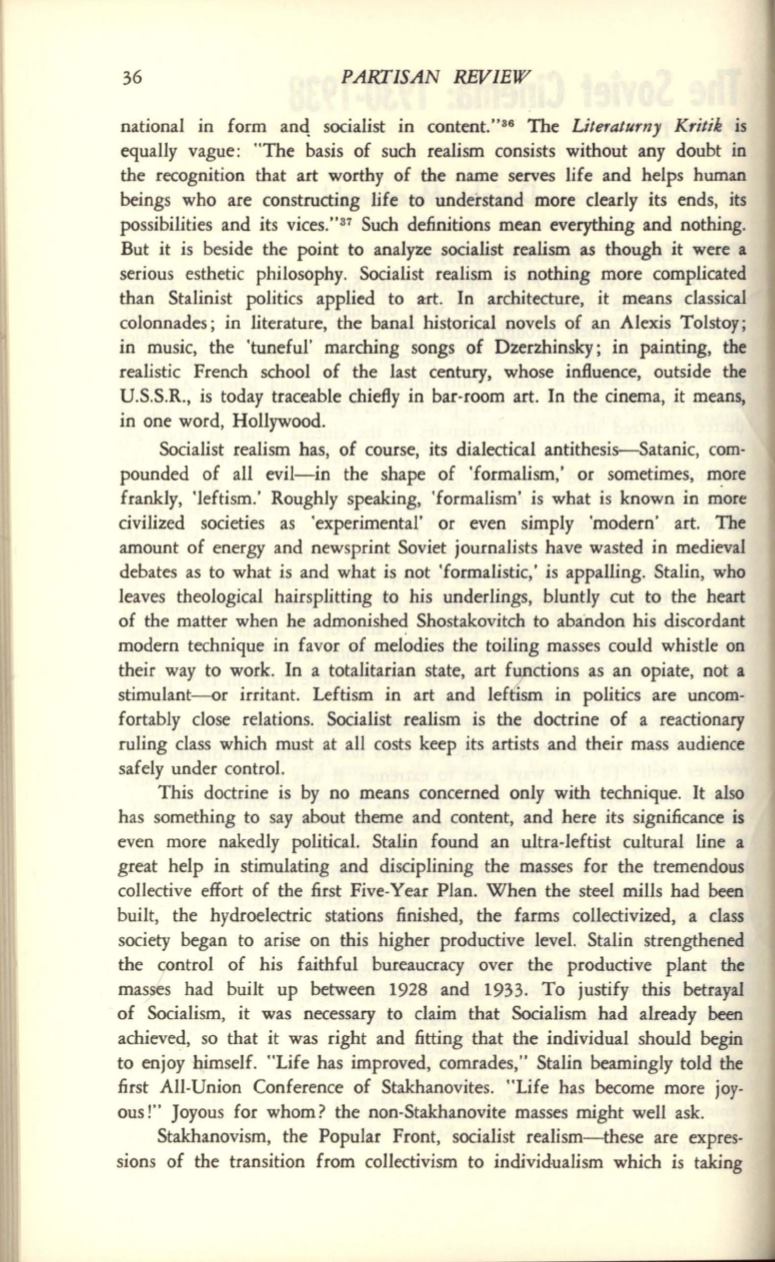
36
PARIISAN REVIEW
national in form anq socialist in content."86 The
Literaturny Kritik
is
equally vague: "The basis of such realism consists without any doubt in
the recognition that art worthy of the name serves life and helps human
beings who are constructing life to understand more clearly its ends, its
possibilities and its vices."87 Such definitions mean everything and nothing.
But it is beside the point to analyze socialist realism as though it were a
serious esthetic philosophy. Socialist realism is nothing more complicated
than Stalinist politics applied to art. In architecture, it means classical
colonnades; in literature, the banal historical novels of an Alexis Tolstoy;
in music, the 'tuneful' marching songs of Dzerzhinsky; in painting, the
realistic French school of the last century, whose influence, outside the
U.S.S.R., is today traceable chiefly in bar·room art. In the cinema, it means,
in one word, Hollywood.
Socialist realism has, of course, its dialectical antithesis-Satanic, com·
pounded of all evil-in the shape of 'formalism: or sometimes, m.ore
frankly, 'leftism.' Roughly speaking, 'formalism' is what is known in more
civilized societies as 'experimental' or even simply 'modern' art. The
amount of energy and newsprint Soviet journalists have wasted in medieval
debates as to what is and what is not 'formalistic: is appalling. Stalin, who
leaves theological hairsplitting to his underlings, bluntly cut to the heart
of the matter when he admonished Shostakovitch to aba·ndon his discordant
modern technique in favor of melodies the toiling masses could whistle on
their way to work. In a totalitarian state, art
f~ctions
as an opiate, not a
stimulant--or irritant. Leftism in art and leftism in politics are uncom–
fortably close relations. Socialist realism is the doctrine of a reactionary
ruling class which must at all costs keep its artists and their mass audience
safely under control.
This doctrine is by no means concerned only with technique. It also
has something to say about theme and content, and here its significance is
even more nakedly political. Stalin found an ultra-leftist cultural line a
great help in stimulating and disciplining the masses for the tremendous
collective effort of the first Five-Year Plan. When the steel mills had been
built, the hydroelectric stations finished, the farms collectivized, a class
society began to arise on this higher productive level. Stalin strengthened
the control of his faithful bureaucracy over the productive plant the
masses had built up between
1928
and
1933.
To justify this betrayal
of Socialism, it was necessary to claim that Socialism had already been
achieved, so that it was right and fitting that the individual should begin
to enjoy himself. "Life has improved, comrades," Stalin beamingly told the
first All-Union Conference of Stakhanovites. "Life has become more joy–
ous!" Joyous for whom? the non-Stakhanovite masses might well ask.
Stakhanovism, the Popular Front, socialist realism-these are expres–
sions of the transition from collectivism to individualism which
is
taking


